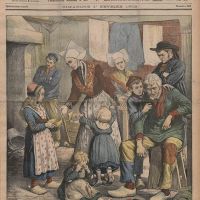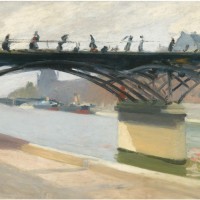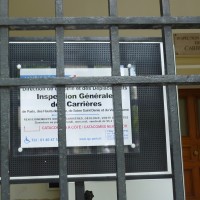“Pssst. Dirty postcards, monsieur?” Is that your image of Paris postcards? Les cartes coquines (naughty or saucy postcards) are still for sale if you know where to look, but there is much more to old Paris postcards. Many of them offer us new ways of seeing, understanding, and remembering Paris. Consider the unusual street scene in the postcard below.
This passerelle improvisée (improvised footbridge) was one of many built in Paris during the great flood of January 1910. That was a one-of-a-kind disaster (I will write more in a subsequent blog), but Parisiens rose to the occasion. Postcard makers also rose to the occasion. Postcards were very big business; three years earlier, France alone had produced a staggering 300 million of them.
The brief handwritten message on the other side claims this is one of the first cards made to capture images of “les inondations.” Who knows which was first? However, this Paris postcard publisher (Editeur le Deley) was particularly adept at spotting opportunities. The logo that appears in the lower right also appears on a few of the cartes coquines.
When I bought my first postcard of the Paris flood, I knew very little about the event, but it aroused my curiosity. I have since read a considerable amount on the subject. This is one of the things I love about old Paris postcards: they point me towards new interests and previously unknown features of the city.
Old Paris postcards also help me see the familiar in new ways.
This one is titled simply Paris Panorama de l’Avenue d’Iéna et de l’Avenue Kléber. These two avenues are part of the spokes that radiate outwards from La Place de L’Etoile (now Place Charles de Gaulle). The Place is most famous as the home of the Arc de Triomphe, which you can see in this photo taken from a balloon at an altitude of about 700 metres.
Interestingly, neither postcard mentions the Arc de Triomphe. But the first of the two is clearly taken from there. The view of the streets tells us we are up high and we can see the characteristic stonework around the perimeter. But how different this view is from photos I have taken from the same vantage point.
In the photo above the Eiffel Tower is clearly visible as in the postcard. And in the foreground we see the characteristic stonework of the top of the Arc de Triomphe. But I had placed the camera to avoid some of the newer additions that interfere with the view. When I took another photo, where the telescope was my main interest, we see a bit of the stonework, but it is now seen beyond a safety fence of steel pickets.
The safety barriers speak of two important trends. One is simply the staggering growth in the number of visitors and the need to modify attractions to make them safer for crowds. The other is a general trend, particularly since the 1950s and 1960s, to legislate ever-greater safety regulations. I’ll leave it to others to argue about the value and aesthetics of modifying historic monuments to make them safer. But this is one of the sights that greets visitors to the Arc these days.
Now let us turn to something familiar to millions of people, including all those who go to or from Paris on the Eurostar. The Gare du Nord looks a little quieter in the postcard shown below than it does today.
Many people search for unused postcards unsullied by dust, grubby hands, and the markings of the postal service. Not me. Yes, this photographic card of the Gare du Nord is in pristine condition. Moreover, the wide street where horsedrawn carriages outnumber automobiles evokes a sense of time and place.
But what really attracted me? Look in the lower right-hand corner. The handwritten comment reads “one of many stations.” And the message on the other side allowed me to peer into the experience of an unnamed visitor who writes:
“This is one of the many stations in Paris. They seem to be about 16 times bigger than the Vane [Vancouver?] one.” (If you are good at old handwriting, have a look at the text, which we have inserted at the end of the blog, and let us know what you think it says.) Then after the obligatory “hope you are getting along,” one catches the visitor’s excitement in the observation “there isn’t an inch of space on the streets at all. It being a holiday it is terrific the crowds going to a big concert in the Tuilleries [sic] Gardens.”
It is written in English and there is no room for stamp or address, so it was probably sent in an envelope.
We are also probably safe in guessing that the unknown visitor went to see the Eiffel Tower. People have been flocking to it ever since it opened. But how many visitors made a special trip to see the pedestrian footbridge shown below?
That suspension bridge was on my must-see list. In the next blog, I will tell you why. I’ll also let you know where to find old Paris postcards and explain why some of my best Paris postcards aren’t about Paris at all.
Meanwhile, here’s that message. Can you decipher it?
Text and photographs by Norman Ball.






























This is brilliant, and novel. What a marvellous entry. It’s a great start to my weekend. Thank you.
Another great post, and I love all the pictures of cards you have picked up on your travels.
The picture of the sign on top of the Arc de Triomphe telling visitors what not to do also made me laugh – when my friends and I visited Paris last June we noticed that for the first time and got a little hysterical over the bizarre images they had chosen for the sign. The cellphone looks like a juicebox, and it also looks like they’re banning men from the top of the building!
Hi. We walked that footbridge on our last trip after a nice picnic. My wife is nuts about old postcards too.
Thanks for the post.
Pingback: On reaching 100 – blogs, that is | Parisian Fields
I spend four weeks twice a year in Paris and enjoy looking for and buying old, always written on postcards of Paris. Delightful post. Thank you. Shannon
Hi,
Just came across your blog – very interesting. Where exactly is the pedestrian bridge?
Red.
The pedestrian bridge is the Parc des Buttes Chaumont. You can see another view of it here: https://parisianfields.wordpress.com/2013/05/26/buttes-chaumont/